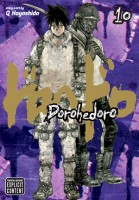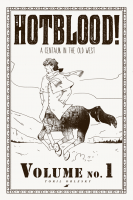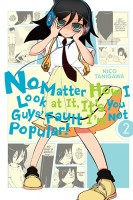My News and Reviews
Well, it was my intention to review the first omnibus of Whispered Words by Takashi Ikeda last week, but then Sean reviewed it the day before I was planning to post my review. So, to avoid making the Manga Bookshelf front page look a little strange, I decided to bump my Whispered Words review to later this week. But never fear, I had other posts in reserve! First up was my Toronto Comic Arts Festival 2014 recap, which is very, very long. If you don’t feel like reading the whole thing, that’s fine, but I do want people to know that TCAF is an amazing festival. A month or so ago I had the opportunity to attend a presentation given by Natsuki Kikuya, a sake sommelier and from a centuries-old family of sake brewers in Tōhoku, about the brewing of sake, its history, and current trend in the industry, so I posted some random musings about that as well—Cultures of Japanese Sake. I was quite pleased to discover that I actually had already had a strong introduction to the subject from reading manga, specifically Oishinbo, A la Carte: Sake and Moyasimon.
Now, going back to TCAF for a moment: Heidi MacDonald has an excellent summary of the festival at Publishers Weekly; the Beat has audio for a selection of the panels available for listening; and Okazu’s Erica Friedman has a great recap of the est em panel, which she moderated. Unrelated to TCAF, but still worth reading: Marvel, Yen Caught in Amazon-Hachette Crossfire; an interview with Leyla Aker, the editor at Viz Media responsible for Kohske’s Gangsta series; and Tokyo Government Declares Imōto Paradise! 2 Manga Unhealthy. Also, Deb Aoki has started updating her site Manga Comics Manga with some interesting new material, including Japanese to Spanish Manga Translation: Readers Speak Out and What Would Make Manga More Appealing to Comics Fans? + 24 Manga for New Readers.
Quick Takes
 Dictatorial Grimoire, Volume 3: Red Riding Hood by Ayumi Kanou. The first volume of Dictatorial Grimoire, as ridiculous as it was, entertained me. The second volume was no less ridiculous, and it had some great moments, but I was frustrated by how trope-based it was. Fortunately, the series’ originality largely returns in the third volume and Dictatorial Grimoire once again becomes a glorious mess. The plot actually starts to make a little more sense and even becomes somewhat interesting, but just as things start to really get going the story is quickly brought to an end. It feels very abrupt and truncated, as if the series was initially supposed to be much longer. Still, I think the third volume of Dictatorial Grimoire was actually my favorite in the series. The demon from which the story Red Riding Hood comes is thoroughly introduced and he’s pretty great—a mix of the Wolf, Hunter, and Red. (He’s actually a decent guy once he gets his werewolf problem under control.) I also get a kick out of Snow White’s animal companions. Instead of the cute woodland critters that might traditionally be expected, he always has some poisonous creatures hanging about. Dictatorial Grimoire is far from the best manga out there, but it can be fun in all of its ridiculousness.
Dictatorial Grimoire, Volume 3: Red Riding Hood by Ayumi Kanou. The first volume of Dictatorial Grimoire, as ridiculous as it was, entertained me. The second volume was no less ridiculous, and it had some great moments, but I was frustrated by how trope-based it was. Fortunately, the series’ originality largely returns in the third volume and Dictatorial Grimoire once again becomes a glorious mess. The plot actually starts to make a little more sense and even becomes somewhat interesting, but just as things start to really get going the story is quickly brought to an end. It feels very abrupt and truncated, as if the series was initially supposed to be much longer. Still, I think the third volume of Dictatorial Grimoire was actually my favorite in the series. The demon from which the story Red Riding Hood comes is thoroughly introduced and he’s pretty great—a mix of the Wolf, Hunter, and Red. (He’s actually a decent guy once he gets his werewolf problem under control.) I also get a kick out of Snow White’s animal companions. Instead of the cute woodland critters that might traditionally be expected, he always has some poisonous creatures hanging about. Dictatorial Grimoire is far from the best manga out there, but it can be fun in all of its ridiculousness.
 Dorohedoro, Volumes 10-12 by Q Hayashida. I continue to enjoy Dorohedoro immensely. It’s a strange, weird manga, and one that I find difficult to coherently explain to people. Dorohedoro is bloody, violent, and grim and yet at the same time it is also incredibly endearing, charming, and funny. It can even be heartbreaking from time to time. Occasionally something feels a little bit off about Hayashida’s artwork in the series—body proportions don’t always seem to be quite right—but for the most part I really enjoy the gritty look and feel of Dorohedoro. I was particularly impressed by how effectively dizzying and disconcerting the artwork could be when Aikawa’s magic comes into play. There’s quite a bit of plot development in these volumes and several of the characters have their backstories filled out—more is learned about the pasts of Nikaido, Asu, and the various members of the Cross-Eyes. There’s plenty of action in this part of the series, too, including excellent fight sequences and brutal battles. There are some significant deaths, as well, though it’s never certain that someone will stay completely dead in Dorohedoro. There are seven more volumes to go in the series; I really hope that Viz will be able to stick with it through to the end.
Dorohedoro, Volumes 10-12 by Q Hayashida. I continue to enjoy Dorohedoro immensely. It’s a strange, weird manga, and one that I find difficult to coherently explain to people. Dorohedoro is bloody, violent, and grim and yet at the same time it is also incredibly endearing, charming, and funny. It can even be heartbreaking from time to time. Occasionally something feels a little bit off about Hayashida’s artwork in the series—body proportions don’t always seem to be quite right—but for the most part I really enjoy the gritty look and feel of Dorohedoro. I was particularly impressed by how effectively dizzying and disconcerting the artwork could be when Aikawa’s magic comes into play. There’s quite a bit of plot development in these volumes and several of the characters have their backstories filled out—more is learned about the pasts of Nikaido, Asu, and the various members of the Cross-Eyes. There’s plenty of action in this part of the series, too, including excellent fight sequences and brutal battles. There are some significant deaths, as well, though it’s never certain that someone will stay completely dead in Dorohedoro. There are seven more volumes to go in the series; I really hope that Viz will be able to stick with it through to the end.
 Hotblood!: A Centaur in the Old West, Volume 1 by Toril Orlesky. While at TCAF, I made the point to pick up a few things that I hadn’t heard about before or was otherwise unfamiliar with. One of those random splurges was Orlesky’s Hotblood!, a webcomic that currently updates twice a week on Tuesdays and Thursdays. I am absolutely loving it—the characters, the art, everything. The first print volume collects the series’ prologue and the entirety of its first chapter, as well as an exclusive appendix and other additional bonus material. Tremendous thought and care has been put into the worldbuilding of the comic—a sort of alternative history—especially in regards to the relationships and interactions between humans and centaurs and their cultures. The story begins in Wyoming in 1873 with James Rook, the titular centaur, and Asa Langley a steel magnate on the run as wanted men. It then jumps back two years in time to when they first met. In the prologue the two are obviously very close, but at the beginning of their relationship they didn’t get along much at all. Langley is a bit of a jerk, frequently making jokes in poor taste at Rook’s expense, but Rook needs a job so he puts up with it. He has been assigned to be Langley’s secretary; neither one of them is particularly happy about it, though.
Hotblood!: A Centaur in the Old West, Volume 1 by Toril Orlesky. While at TCAF, I made the point to pick up a few things that I hadn’t heard about before or was otherwise unfamiliar with. One of those random splurges was Orlesky’s Hotblood!, a webcomic that currently updates twice a week on Tuesdays and Thursdays. I am absolutely loving it—the characters, the art, everything. The first print volume collects the series’ prologue and the entirety of its first chapter, as well as an exclusive appendix and other additional bonus material. Tremendous thought and care has been put into the worldbuilding of the comic—a sort of alternative history—especially in regards to the relationships and interactions between humans and centaurs and their cultures. The story begins in Wyoming in 1873 with James Rook, the titular centaur, and Asa Langley a steel magnate on the run as wanted men. It then jumps back two years in time to when they first met. In the prologue the two are obviously very close, but at the beginning of their relationship they didn’t get along much at all. Langley is a bit of a jerk, frequently making jokes in poor taste at Rook’s expense, but Rook needs a job so he puts up with it. He has been assigned to be Langley’s secretary; neither one of them is particularly happy about it, though.
 No Matter How I Look at It, It’s You Guys’ Fault I’m Not Popular!, Volumes 2-3 by Nico Tanigawa. Overall, I do enjoy WataMote, but I will be the first to admit that it can be a harsh and uncomfortable read. (I get the feeling that the creators largely didn’t enjoy their high school years and that they don’t have many fond memories of that time in their lives.) WataMote can be very funny, but it’s not always very pleasant. So far the series has been fairly episodic, which is both an advantage and a disadvantage, but a few characters have been introduced in these volumes which may change that. I would like to see some actual character development in the series, though. Right now it seems as though Tomoko, her family, and classmates are stuck in a rut. This works in terms of the series’ premise—Tomoko is a misfit to put all other misfits to shame—but it’s a little painful and sad to not see her learn from her mistakes and experiences. Which, I suppose, is actually probably one of the points of the manga. Tomoko can be endearing in her extreme awkwardness, but that awkwardness can also be fairly alarming and embarrassing. WataMote is definitely not a series that everyone will be able to enjoy or even appreciate, but I do plan on following it further.
No Matter How I Look at It, It’s You Guys’ Fault I’m Not Popular!, Volumes 2-3 by Nico Tanigawa. Overall, I do enjoy WataMote, but I will be the first to admit that it can be a harsh and uncomfortable read. (I get the feeling that the creators largely didn’t enjoy their high school years and that they don’t have many fond memories of that time in their lives.) WataMote can be very funny, but it’s not always very pleasant. So far the series has been fairly episodic, which is both an advantage and a disadvantage, but a few characters have been introduced in these volumes which may change that. I would like to see some actual character development in the series, though. Right now it seems as though Tomoko, her family, and classmates are stuck in a rut. This works in terms of the series’ premise—Tomoko is a misfit to put all other misfits to shame—but it’s a little painful and sad to not see her learn from her mistakes and experiences. Which, I suppose, is actually probably one of the points of the manga. Tomoko can be endearing in her extreme awkwardness, but that awkwardness can also be fairly alarming and embarrassing. WataMote is definitely not a series that everyone will be able to enjoy or even appreciate, but I do plan on following it further.

Speak Your Mind